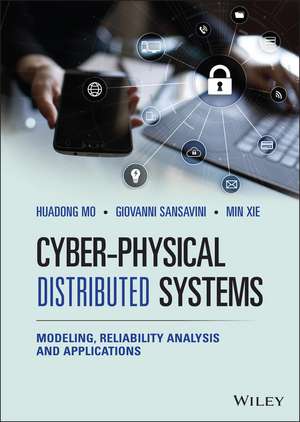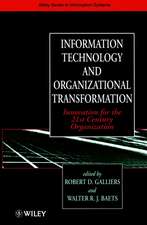Cyber–Physical Distributed Systems – Modeling, Reliability Analysis and Applications
Autor H Moen Limba Engleză Hardback – 8 sep 2021
Gather detailed knowledge and insights into cyber-physical systems behaviors from a cutting-edge reference written by leading voices in the field
In Cyber-Physical Distributed Systems: Modeling, Reliability Analysis and Applications, distinguished researchers and authors Drs. Huadong Mo, Giovanni Sansavini, and Min Xie deliver a detailed exploration of the modeling and reliability analysis of cyber physical systems through applications in infrastructure and energy and power systems. The book focuses on the integrated modeling of systems that bring together physical and cyber elements and analyzing their stochastic behaviors and reliability with a view to controlling and managing them.
The book offers a comprehensive treatment on the aging process and corresponding online maintenance, network degradation, and cyber-attacks occurring in cyber-physical systems. The authors include many illustrative examples and case studies based on real-world systems and offer readers a rich set of references for further research and study.
Cyber-Physical Distributed Systems covers recent advances in combinatorial models and algorithms for cyber-physical systems modeling and analysis. The book also includes:
- A general introduction to traditional physical/cyber systems, and the challenges, research trends, and opportunities for real cyber-physical systems applications that general readers will find interesting and useful
- Discussions of general modeling, assessment, verification, and optimization of industrial cyber-physical systems
- Explorations of stability analysis and enhancement of cyber-physical systems, including the integration of physical systems and open communication networks
- A detailed treatment of a system-of-systems framework for the reliability analysis and optimal maintenance of distributed systems with aging components
Perfect for undergraduate and graduate students in computer science, electrical engineering, cyber security, industrial and system engineering departments, Cyber-Physical Distributed Systems will also earn a place on the bookshelves of students taking courses related to reliability, risk and control engineering from a system perspective. Reliability, safety and industrial control professionals will also benefit greatly from this book.
Preț: 810.34 lei
Preț vechi: 890.48 lei
-9% Nou
155.11€ • 168.54$ • 130.37£
Carte tipărită la comandă
Livrare economică 21 aprilie-05 mai
Specificații
ISBN-10: 1119682673
Pagini: 224
Dimensiuni: 176 x 244 x 20 mm
Greutate: 0.56 kg
Editura: Wiley
Locul publicării:Chichester, United Kingdom
Notă biografică
Huadong Mo, PhD, is Senior Lecturer in the School of Engineering and Information Technology at the University of New South Wales. He received his doctorate from the City University of Hong Kong in the area of cyber-physical system reliability engineering. Giovanni Sansavini, PhD, is Associate Professor at the Reliability and Risk Engineering Laboratory, Institute of Energy and Process Engineering, ETH Zurich, Switzerland. He is also the director of Reliability and Risk Engineering Laboratory, in the Institute of Energy and Process Engineering, Department of Mechanical and Process Engineering. He received his doctorate in nuclear engineering in 2010 from Politecnico di Milano, Italy, and a doctorate in engineering mechanics from Virginia Tech in Blacksburg in 2010. Min Xie, PhD, is Chair Professor of Industrial Engineering in the Department of Advanced Design and Systems Engineering, at City University of Hong Kong. He received his doctorate in Quality Technology in 1987 from Linkoping University in Sweden and was elected as a Fellow of the IEEE in 2006.
Descriere
CYBER-PHYSICAL DISTRIBUTED SYSTEMS
Gather detailed knowledge and insights into cyber-physical systems behaviors from a cutting-edge reference written by leading voices in the field
In Cyber-Physical Distributed Systems: Modeling, Reliability Analysis and Applications, distinguished researchers and authors Drs. Huadong Mo, Giovanni Sansavini, and Min Xie deliver a detailed exploration of the modeling and reliability analysis of cyber physical systems through applications in infrastructure and energy and power systems. The book focuses on the integrated modeling of systems that bring together physical and cyber elements and analyzing their stochastic behaviors and reliability with a view to controlling and managing them.
The book offers a comprehensive treatment on the aging process and corresponding online maintenance, network degradation, and cyber-attacks occurring in cyber-physical systems. The authors include many illustrative examples and case studies based on real-world systems and offer readers a rich set of references for further research and study.
Cyber-Physical Distributed Systems covers recent advances in combinatorial models and algorithms for cyber-physical systems modeling and analysis. The book also includes:
- A general introduction to traditional physical/cyber systems, and the challenges, research trends, and opportunities for real cyber-physical systems applications that general readers will find interesting and useful
- Discussions of general modeling, assessment, verification, and optimization of industrial cyber-physical systems
- Explorations of stability analysis and enhancement of cyber-physical systems, including the integration of physical systems and open communication networks
- A detailed treatment of a system-of-systems framework for the reliability analysis and optimal maintenance of distributed systems with aging components
Perfect for undergraduate and graduate students in computer science, electrical engineering, cyber security, industrial and system engineering departments, Cyber-Physical Distributed Systems will also earn a place on the bookshelves of students taking courses related to reliability, risk and control engineering from a system perspective. Reliability, safety and industrial control professionals will also benefit greatly from this book.


























